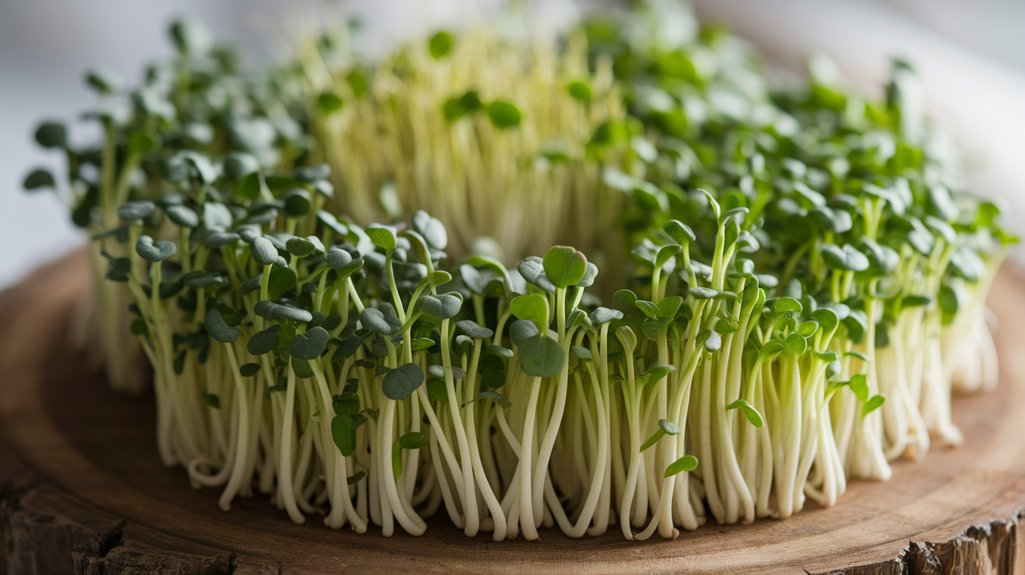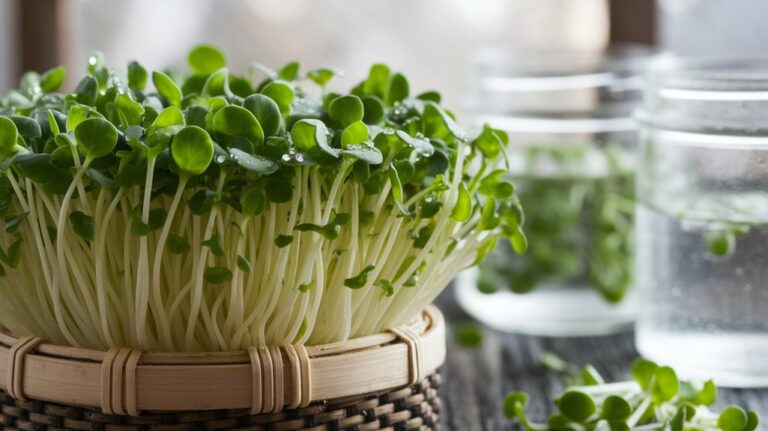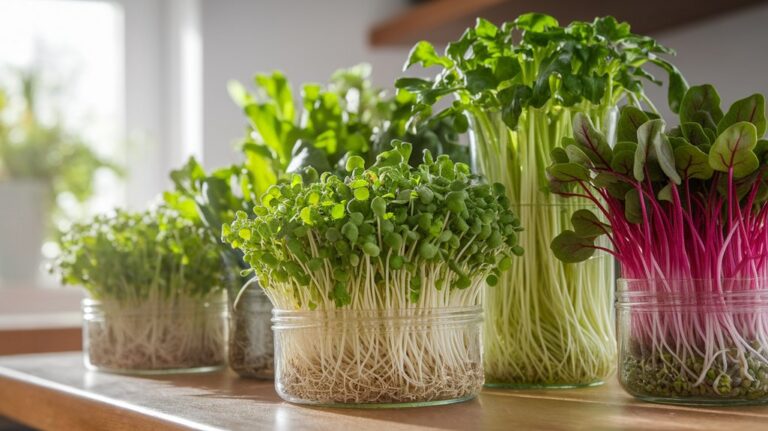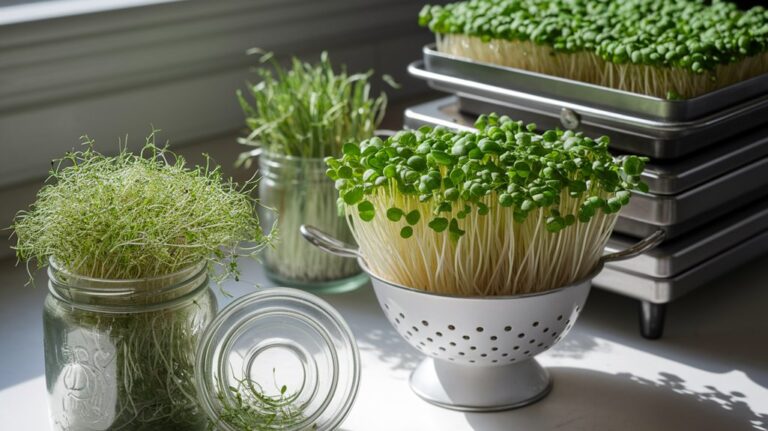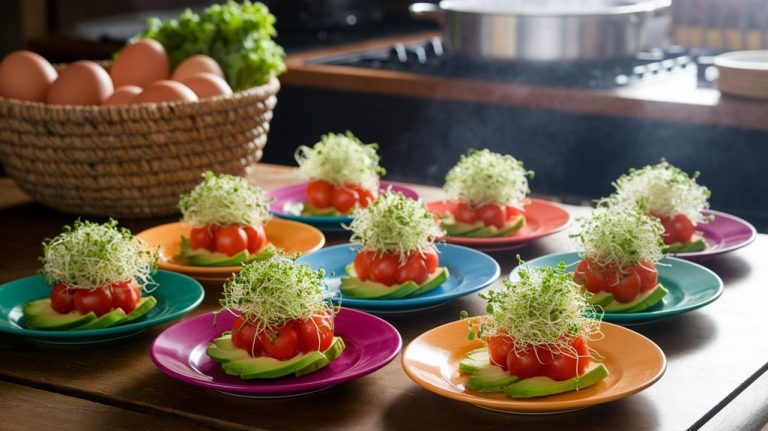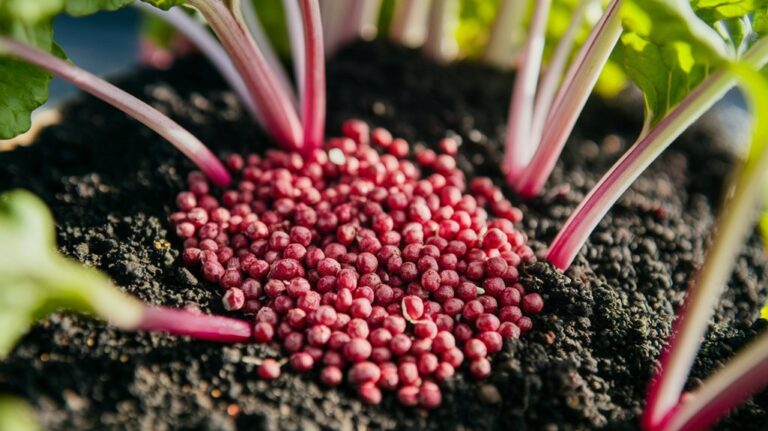Sprout Flavor Profiles: How Seed Selection Changes Taste
When I explore sprout flavor profiles, I find that seed selection plays a crucial role in their taste and texture. For instance, alfalfa sprout seeds yield a mild, nutty flavor, while broccoli sprout seeds produce a slightly peppery taste. These characteristics not only affect the sprouts themselves but also their culinary applications. Understanding how different seeds influence flavor can enhance your dishes, opening the door to exciting combinations and pairings in the kitchen. There’s so much more to discover.
Key Takeaways
- Seed variety significantly impacts the flavor profile of sprouts, influencing bitterness, sweetness, and crunchiness in the final product.
- Alfalfa sprouts are crunchy and mildly nutty, making them versatile for various dishes.
- Broccoli sprouts have an earthy, slightly bitter taste due to glucosinolates, enhancing nutritional value.
- Radish sprouts provide a spicy kick and vibrant crunch, ideal for salads and sandwiches.
- Growing conditions, such as soil quality and light, also affect the flavor profiles of different sprout varieties.
Understanding the Basics of Sprout Flavor Profiles
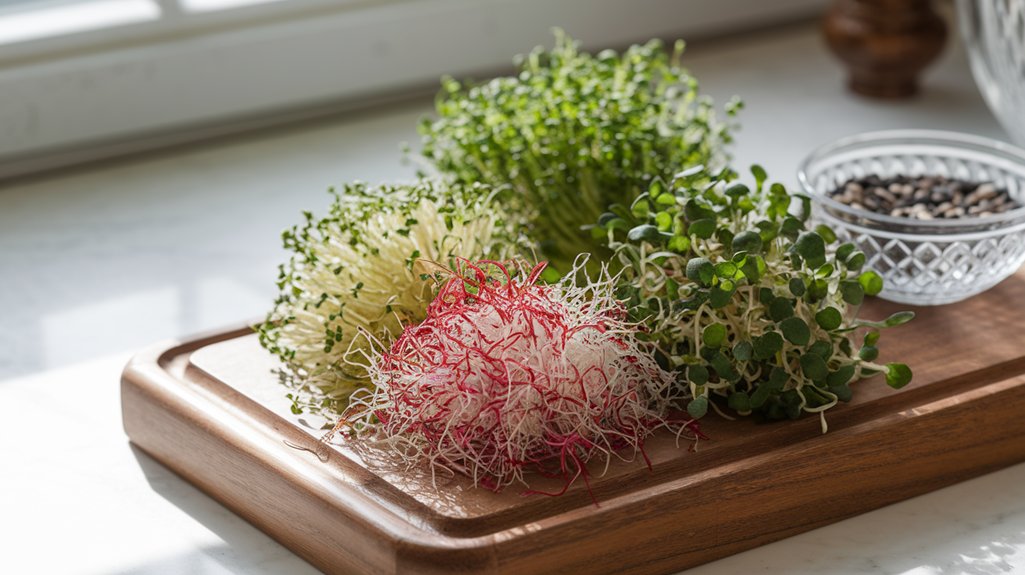
How do different sprout varieties influence flavor profiles?
When I explore the world of sprouts, I find that each variety offers a unique taste experience. For instance, alfalfa sprouts tend to have a mild, slightly nutty flavor, while radish sprouts pack a peppery punch. The difference lies in their genetic makeup and the compounds they produce during growth.
Broccoli sprouts, rich in glucosinolates, provide a distinct, earthy flavor that can elevate any dish. Additionally, the sprouting process affects flavor intensity; younger sprouts often taste milder than their mature counterparts.
The Impact of Seed Variety on Taste
While exploring different seed varieties, I’ve come to appreciate how each type can significantly influence taste in the final product. It’s fascinating how nuanced flavors can emerge from seemingly simple choices in seed selection. For instance, the level of bitterness, sweetness, or crunchiness can vary dramatically.
Here’s a quick look at how different seed varieties can impact flavor:
| Seed Variety | Flavor Profile | Notable Characteristics |
|---|---|---|
| Alfalfa | Mild, nutty | Crunchy texture, versatile use |
| Broccoli | Earthy, slightly bitter | High in nutrients, robust flavor |
| Radish | Peppery, zesty | Adds spice, vibrant in salads |
Each seed brings its unique attributes to the table, making thoughtful selection crucial for achieving desired taste outcomes.
Exploring Popular Sprout Types and Their Flavors
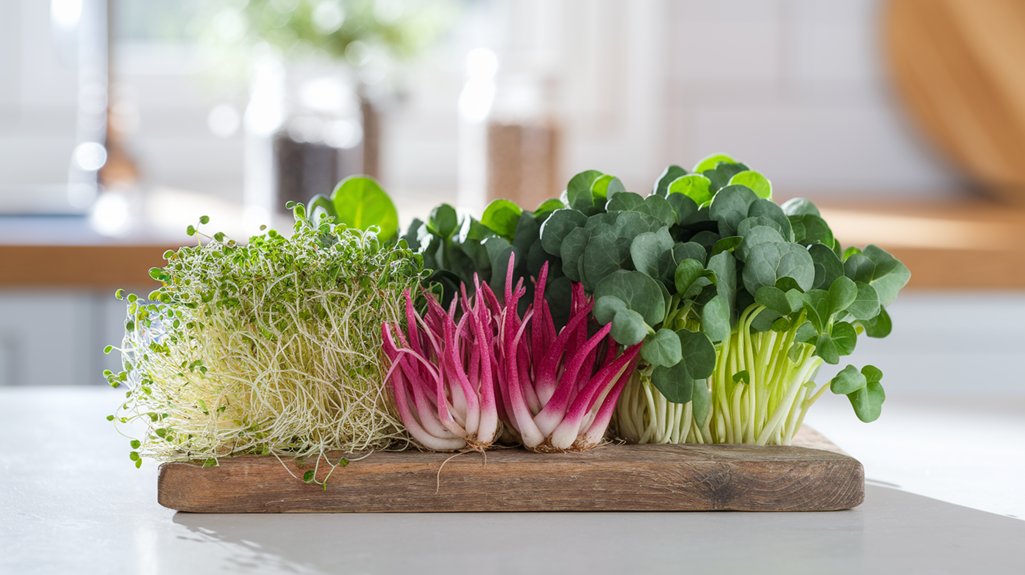
In this section, I’ll explore the diverse flavors of popular sprout types, particularly those from the Brassica family and legumes.
Each variety brings unique taste profiles that can enhance various dishes. Understanding their culinary uses and ideal pairings will help you maximize their flavor potential in your meals.
Brassica Family Varieties
Brassica family varieties, which include an array of popular sprouts, offer a fascinating exploration of flavors that can elevate any dish. Among these, broccoli sprouts stand out with their mild, slightly peppery taste, making them perfect for salads and sandwiches.
Then there are radish sprouts, which pack a spicy punch and add a delightful crunch to any meal. Kale sprouts, on the other hand, provide a subtle earthiness, enriching dishes without overwhelming them.
I find that the versatility of these sprouts allows for creative culinary applications, from garnishing soups to enhancing grain bowls. Understanding the distinct flavors of Brassica varieties helps me select the right sprout to complement my dishes, ensuring a balanced and flavorful experience.
Legume Sprout Taste Profiles
As I dive into the world of legume sprouts, I discover a diverse range of flavors that can enhance my culinary creations. Each type brings its unique taste profile, which can transform dishes in surprising ways. Here’s a quick overview of some popular legume sprouts:
| Sprout Type | Flavor Profile | Key Characteristics |
|---|---|---|
| Mung Bean Sprouts | Crisp, slightly sweet | Tender texture, versatile |
| Lentil Sprouts | Earthy, nutty | Robust flavor, high in protein |
| Chickpea Sprouts | Mild, creamy | Firm texture, rich in fiber |
Understanding these profiles helps me select the right sprout for my recipes, ensuring that each dish bursts with flavor and nutritional benefits.
Culinary Uses and Pairings
While exploring the diverse culinary landscape of legume sprouts, I’ve found that each type not only enhances dishes with its unique flavor but also pairs beautifully with various ingredients.
For instance, mung bean sprouts offer a crisp, mildly sweet taste, making them perfect for stir-fries and salads. In contrast, lentil sprouts provide a nutty flavor that complements earthy dishes, such as grain bowls or soups.
Chickpea sprouts, with their creamy texture, can elevate hummus or wraps. The key to successful pairings lies in balancing flavors; for example, spicy ingredients like radishes can offset the sweetness of mung beans, while fresh herbs enhance the overall profile.
Experimenting with these combinations can truly transform your culinary experience.
Cultivating Different Flavor Profiles in Your Kitchen
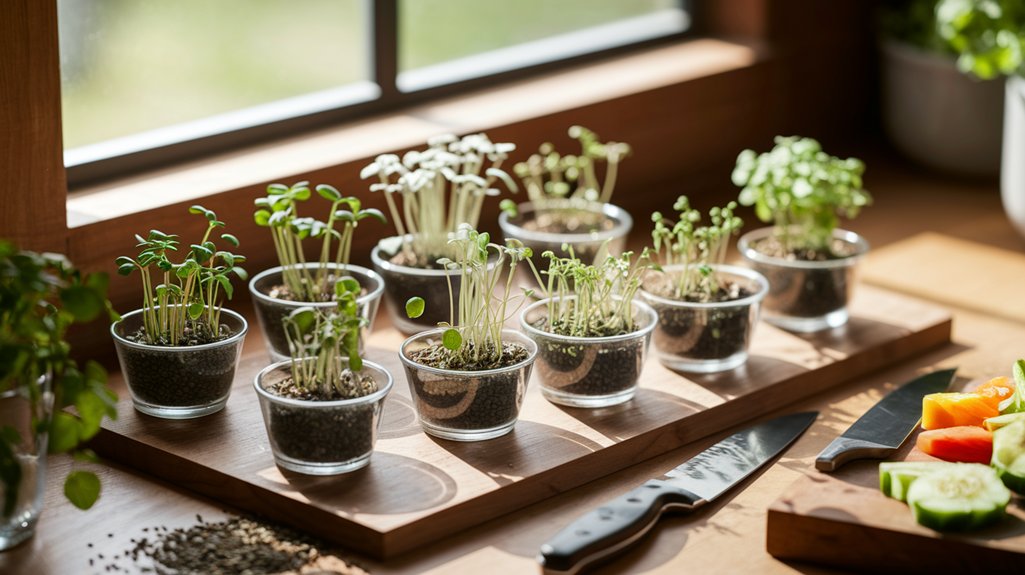
In my experience, the variety of seeds I choose significantly impacts the flavors I can cultivate in my kitchen.
Different growing conditions also play a crucial role in enhancing or diminishing those flavors.
Seed Variety Impacts Flavor
Choosing the right seed variety can significantly alter the flavor profile of the plants you cultivate in your kitchen garden. For instance, heirloom tomatoes often pack a richer, sweeter taste compared to their hybrid counterparts.
When I select basil, I prefer the Genovese variety for its robust aroma and distinct flavor, which elevates my dishes. Similarly, different pepper varieties can range from sweet to fiery, impacting the overall taste experience.
Even in leafy greens, the variety can dictate bitterness levels; I’ve found that butterhead lettuce offers a milder flavor than romaine. By understanding these distinctions, I can strategically select seeds that align with my culinary goals, ultimately enhancing the flavor and enjoyment of my home-cooked meals.
Growing Conditions and Taste
The influence of growing conditions on flavor can’t be overstated. When I cultivate my sprouts, I notice how factors like soil quality, light, and moisture directly affect their taste.
For instance, nutrient-rich soil often enhances sweetness, while insufficient light can lead to blandness. I’ve found that adjusting water levels also plays a crucial role; too much can dilute flavor, while just the right amount encourages robust growth and a more intense taste.
Temperature fluctuates similarly—warmer conditions can accelerate growth, but if they’re too extreme, it can stunt flavor development.
Pairing Sprouts With Other Ingredients for Enhanced Taste
While exploring the world of sprouts, I’ve discovered that pairing them with complementary ingredients can significantly enhance their flavor profiles.
For instance, I find that the nutty taste of sunflower sprouts pairs beautifully with avocado, creating a creamy, rich texture. Meanwhile, the peppery kick of arugula sprouts works well with citrus-based dressings, balancing their boldness with refreshing acidity.
I also enjoy mixing radish sprouts with tangy feta cheese, which elevates the dish’s overall complexity. Additionally, incorporating herbs like cilantro or basil can add depth and aromatic nuances to the sprouts.
Tips for Selecting Seeds Based on Flavor Preferences
How do you determine which seeds align with your flavor preferences? Start by considering the taste profiles of different sprouts. For instance, radish seeds yield a peppery flavor, while broccoli sprouts offer a milder, nutty note.
Next, think about your culinary goals—are you seeking a bold accent or a subtle complement? Researching seed varieties can provide insights into their flavor characteristics.
Additionally, pay attention to the growing conditions; sprouts grown in optimal light and moisture often achieve richer flavors.
Finally, don’t hesitate to taste-test a few varieties. I’ve found that personal experience is invaluable in selecting seeds that truly resonate with my palate.
Choose wisely, and you’ll elevate your culinary creations with the right sprout flavors.
Experimenting With Flavor Combinations in Sprout Dishes
When I explore flavor combinations in sprout dishes, I find that the key lies in understanding how different sprouts interact with various ingredients. For instance, pairing the nutty flavor of sunflower sprouts with tangy citrus can elevate a dish. Similarly, the peppery notes of radish sprouts contrast beautifully with creamy textures.
Here’s a quick guide to some combinations I’ve experimented with:
| Sprout Type | Flavor Pairing |
|---|---|
| Sunflower Sprouts | Citrus, Avocado |
| Radish Sprouts | Creamy Dressings, Cheese |
| Pea Shoots | Nuts, Garlic |
Frequently Asked Questions
How Do Environmental Factors Influence Sprout Flavor?
Environmental factors like light, temperature, and moisture really shape sprout flavor.
I’ve noticed that sprouts grown in brighter conditions tend to develop a more robust taste, while those in cooler temperatures often taste milder.
Moisture levels also play a role; too much can lead to bitterness, whereas just the right amount enhances sweetness.
Can I Save Seeds From My Own Sprouts?
Yes, you can save seeds from your own sprouts! I’ve done it myself, and it’s quite rewarding.
First, allow the sprouts to mature and flower. Once they produce seeds, carefully collect and dry them.
Make sure you choose healthy plants for the best seed quality. Store the seeds in a cool, dark place to maintain their viability.
This way, you can grow your favorite sprouts again and again!
What Is the Best Time to Harvest Sprouts for Flavor?
When it comes to harvesting sprouts for the best flavor, I’ve found timing is crucial.
I usually wait until the sprouts have developed their first true leaves, typically around 5 to 14 days after germination. This stage balances flavor intensity and tenderness.
If I harvest too early, the sprouts can taste bland; if I wait too long, they may become bitter.
Are There Any Health Benefits Associated With Specific Sprout Flavors?
Yes, I’ve found that specific sprout flavors often come with distinct health benefits.
For instance, broccoli sprouts are packed with sulforaphane, known for its cancer-fighting properties. Meanwhile, radish sprouts can aid digestion due to their high fiber content.
Each flavor profile can indicate a particular nutrient composition, which can enhance our diets. By choosing sprout flavors wisely, I can enjoy both taste and health advantages, making my meals more nutritious and satisfying.
How Do Growing Methods Affect the Taste of Sprouts?
Growing methods significantly impact the taste of sprouts. For instance, I’ve noticed that hydroponically grown sprouts often have a milder flavor compared to those grown in soil, which tend to develop richer, earthier tastes.
Additionally, the amount of light and nutrients I provide influences their sweetness and bitterness. By experimenting with different methods, I can enhance or alter the flavors, making the growing process an essential factor in achieving the desired taste profile.
Conclusion
In conclusion, understanding how seed selection influences sprout flavor profiles can elevate your culinary creations. By exploring various seed varieties and their unique tastes, you can cultivate a diverse range of flavors in your kitchen. Pairing sprouts with complementary ingredients enhances these profiles, allowing for delightful combinations. I encourage you to experiment with different seeds and flavors, as this exploration not only enriches your dishes but also deepens your appreciation for the intricate world of sprouts.

